Recommendations That Got Results
Each month, we shine the spotlight on a few recommendations that have been successfully implemented (closed acceptable action) and are helping to improve safety. These recommendations span all modes of transportation:
We urge recommendation recipients to keep us informed of their progress toward implementing recommendations.

Making One of the Most Hazardous Jobs in Aviation Less Risky
From April through October, thousands of agricultural pilots take to the skies to safeguard the 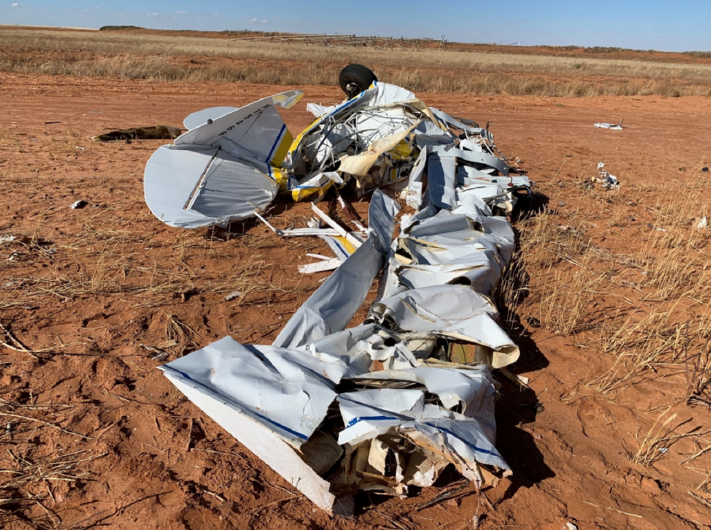 nation’s crops, often flying just feet above the ground in one of aviation’s most hazardous jobs. Recognizing the risks, the NTSB has spent years working to improve safety in this critical sector.
nation’s crops, often flying just feet above the ground in one of aviation’s most hazardous jobs. Recognizing the risks, the NTSB has spent years working to improve safety in this critical sector.
On average, about 54 agriculture aircraft crashes occur in the U.S. each year, with roughly 22 percent resulting in fatalities, according to the National Agricultural Aviation Association (NAAA) ag aviation accident data summary. With only an estimated 3,400 agriculture pilots in the country, these numbers represent a significant threat to this small, but vital aviation community.
Following NTSB’s special investigation into 78 agricultural aircraft crashes, we issued several safety recommendations aimed at reducing these accidents. We are pleased to report that the NAAA—which represents a significant portion of the U.S. small businesses and pilots licensed as professional commercial aerial applicators—has implemented substantial safety enhancements that go above and beyond our recommendations.
Critical Safety Improvements
The association updated its Agricultural Airman Guidelines (AAG) in line with our recommendation (A-14-29) addressing the leading causes of ag aviation accidents. The enhanced guidelines now include:
- Pre-flight and in-flight site survey checklists
- Managing distraction and avoiding obstacles
- Effects of density altitude
- Crosswinds
- Aircraft weight and balance during critical phases of flight
- Fuel management techniques
- Stall/spin awareness and avoidance
NTSB’s review of the updated AAG found clear, detailed content that equips pilots with the knowledge and tools to mitigate common operational hazards.
We also found NAAA launched an Education Center on its website that exceeds our recommendation (A-14-31). This resource provides online training modules on critical safety topics from the AAG and includes knowledge checks to ensure comprehension.
To further support ag aviation safety and professionalism in the industry, NAAA also offers a Certified-Professional Aerial Applicator Safety Steward (C-PAASS) program. This certification requires pilots to complete the safety training and pass assessments.
Training and certification are free to NAAA members and available for a nominal fee to nonmembers, ensuring broad accessibility to these life-saving resources.
FAA Expands Safety Management System (SMS) Mandate to Charter and Commuter Airlines, Helicopter Air Ambulance and Air Tour Operators, and Certain Aircraft Manufacturers
 In April, the FAA took another major step in improving aviation safety by requiring all Part 135 operators, Part 91 air-tour operations, and certain aircraft manufacturers to implement an SMS within the next three years.
In April, the FAA took another major step in improving aviation safety by requiring all Part 135 operators, Part 91 air-tour operations, and certain aircraft manufacturers to implement an SMS within the next three years.
The new regulation allowed us to recently close three safety recommendations that were issued to the FAA as an acceptable response (A-16-36, A-19-28, and A-22-15). Our investigations of two fatal air tours and a charter flight showed, once again, that SMSs and guidance for operators on how to scale an SMS could prevent similar tragedies from occurring.
In 2007, we issued our first SMS recommendation in aviation (A-07-10), asking the FAA to require SMS for Part 121. Later, in 2009, we recommended that the FAA expand the SMS mandate to helicopter air ambulance operators (A-09-89) and, in 2016, to Part 135 operators (A-16-36). We have reiterated A-16-36 in the final reports of seven fatal accidents involving Part 135 operators, which resulted in 39 fatalities and 9 serious injuries.
Most of these accidents were also on the FAA’s list of 35 serious and fatal injury accidents involving Part 135 operators from 2015 to 2019 that the FAA determined could have been mitigated through the implementation of SMS (FAA 2023a, 1936).
Recently Closed SMS Recommendations
- In 2015, we investigated an on-demand charter flight that crashed into an apartment building in Akron, Ohio, while on its approach to land at Akron Fulton International Airport. The captain, first officer, and seven passengers died; no one on the ground was injured. In our investigation report, we recommended (A-16-36) that the FAA require all Part 135 operators to establish an SMS.
- In 2018, a helicopter carrying passengers on an aerial photography tour of New York City crashed into the East River after losing power. The pilot sustained minor injuries, and the five passengers drowned. Our investigation found many hazardous conditions that could have been identified and mitigated via a SMS’s systematic and continuous approach to reducing risk. We recommended (A-19-28) to the FAA that all commercial air tour operators, regardless of their operating rules, implement a SMS.
- In 2019, a helicopter carrying sightseers collided with terrain in a remote, wooded area on the island of Kauai. The pilot and the six passengers were fatally injured. Our investigation of the crash found several hazardous conditions that could have been identified and addressed via a SMS. We asked the FAA (A-22-15) to develop guidance to help small operators, including air tours, implement an SMS that is scaled to their specific operations.
FAA Tackles Spatial Disorientation Training Gaps Identified in NTSB Aviation Accident Investigations
 The FAA estimates that about 5 to 10 percent of all general aviation accidents can be attributed to spatial disorientation, 90 percent of which are fatal, including the 2020 Sikorsky S–76B helicopter crash in Calabasas, Calif., that killed nine people.
The FAA estimates that about 5 to 10 percent of all general aviation accidents can be attributed to spatial disorientation, 90 percent of which are fatal, including the 2020 Sikorsky S–76B helicopter crash in Calabasas, Calif., that killed nine people.
In our investigation of the Calabasas crash, we determined that the probable cause of the accident was the pilot’s decision to continue to fly under visual flight rules into instrument meteorological conditions. Without good visual cues, the pilot became spatially disoriented and lost control of the helicopter.
Improving Pilot Training
To address the spatial disorientation hazard in the Calabasas crash, we asked the FAA in safety recommendation A-21-006 to evaluate spatial disorientation simulation technologies and identify which are most effective for training pilots to recognize and successfully mitigate the onset of spatial disorientation. We also asked the FAA to report its findings publicly.
The FAA tapped the Air Carrier Training (ACT) Aviation Rulemaking Committee (ARC), which provides a forum for the U.S. aviation community to discuss, prioritize, and provide recommendations to the FAA concerning general aviation operations and specifically addresses air carrier training.
To address NTSB’s recommendation, the ACT formed a Spatial Disorientation Training working group that found well-defined training requirements on spatial disorientation did not exist at any level. The group called spatial disorientation training “foundational” and should be taught at all levels of certification during a pilot’s career. As a result, the working group made several recommendations to strengthen spatial disorientation training for Part 135 helicopter operations.
The working group also published a comprehensive report on simulation training devices suitable for training air carrier pilots to recognize the onset of spatial disorientation and successfully mitigate it.
In May, the NTSB closed safety recommendation, A-21-006, acceptably. The FAA is reviewing the ACT ARC’s recommendations to determine an appropriate action plan; the agency also plans to report its progress to NTSB by the end of this summer.
Improving Air Traffic Controller Training
Following our investigation of a 2015 Cessna 152 crash in New Smyrna Beach, Fla., that killed the pilot, we issued two safety recommendations to the FAA to improve air traffic controllers' management of emergencies, including those caused by spatial disorientation.
Before the New Smyrna Beach crash, the pilot tried to obtain ATC assistance landing her plane when she no longer felt comfortable flying under visual flight rules because night instrument meteorological conditions (IMC) prevailed.
However, the controller who assisted her made missteps in standardized procedures for assisting pilots in emergencies, prompting NTSB to issue two safety recommendations to the FAA (A-16-18 and A-16-19).
In May, we closed those recommendations acceptably after the FAA reported that it had developed scenario-based recurrent training delivered nationally to air traffic controllers and annually revised with the latest lessons learned and best practices from across the National Airspace System on several common aviation emergencies.
The FAA also said the recurrent training on emergencies has been delivered several times since 2019 and is updating it for 2024.
Improving the Chance of Firefighter Survival in Helicopter Crashes
Like many NTSB investigations, it isn't necessarily one significant hazard or unsafe practice that reduces a victim’s chances of surviving a transportation crash, but many small ones. And, sometimes, it takes the NTSB's unwavering persistence over many years for these small safety improvements to occur.
Last month, the NTSB closed the final recommendation from a 2008 crash involving a Sikorsky S-61N helicopter, which impacted trees and terrain after departing a helispot (a location near a fire where it is safe for helicopters to land and take off) near Weaverville, Calif., that killed the pilot, a crewmember, and seven firefighters and seriously injured the co-pilot and three firefighters. The NTSB issued 10 safety recommendations following this crash; the final one to close improves firefighters' survivability after a helicopter crash.
In the Weaverville crash, the firefighter passengers on the accident helicopter were wearing flame-resistant gloves, as required by U.S. Forest Service policy at the time of the accident. However, the gloves were made of a rigid medium-weight leather that hindered the firefighters' ability to quickly unbuckle their seat restraints and open emergency exits after the helicopter crashed.
To address this issue, NTSB recommended (A-10-164) that the Forest Service revise its policies to ensure the gloves firefighting personnel wear during helicopter transport operations are compatible with passenger restraints and opening emergency exits.
In 2023, the Forest Service had implemented the following changes to its policies and guidance:
- All occupants of helicopters under contract with the U.S. Forest Service must wear fire-resistant or leather gloves that fit snugly to provide maximum finger dexterity.
- Pre-flight briefing guidance and checklists cover seatbelt operation, and glove fit and dexterity.
- All helicopters operated under contract to the U.S. Forest Service must be equipped with quick-release buckles, which are easier to operate with gloves than rotary-style buckles like those installed on the accident helicopter.
The U.S. Forest Service's actions to ensure that seatbelt operation and glove fit and dexterity are discussed and checked before flights and that all contracted helicopters are equipped with quick-release buckles exceed the intent of Safety Recommendation
A-10-164, which was classified Closed—Exceeds Recommended Action in February 2024.
Embraer, FAA Address Potential Cause of Several Runway Excursions
Between 2011 and 2013, the NTSB investigated and participated in foreign-led investigations of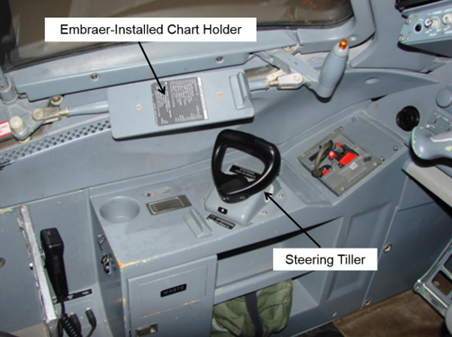 several runway excursions involving Embraer EMB-145 airplanes that unexpectedly veered off the runway during landing due to uncommanded steering anomalies.
several runway excursions involving Embraer EMB-145 airplanes that unexpectedly veered off the runway during landing due to uncommanded steering anomalies.
During our investigations, we discovered Embraer pilots were using binder brackets to clip their open navigation chart binders on the Embraer-installed chart holder, which is designed to hold individual charts and located directly above the steering tiller.
When the binder, about 2 inches thick and weighing several pounds, dislodged from the (unauthorized) bracket, it would strike the tiller, engage the steering system, and cause the plane to veer off the pilot’s intended landing path.
The NTSB recommended (A-17-3) Embraer inform its operators and pilots not to clip binders to the chart holder due to the potentially hazardous condition the act poses. We also recommended (A-17-5) the FAA reinforce Embraer’s outreach by issuing a safety alert to Embraer pilots and operators.
Those communications were completed, and the NTSB recently closed its recommendations to Embraer and the FAA and classified them as acceptable.

FAA Improves Airliner Design Standard to Prevent Recurrence of Second Deadliest Crash in US History
American Airlines Flight 587 crashed into a New York City neighborhood about a month after the Sept.11, 2001, terrorist attacks. The accident killed 260 people on the airplane, and 5 people on the ground; it is the second deadliest airplane crash in the United States. The crash occurred after the pilot made rapid, inappropriate, full-rudder deflections, leading to the plane's tail ripping off midair. Following our investigation, we recommended (A-04-56) that the FAA revise certification standards to ensure the safe handling of airliners in the yaw axis throughout the various phases of flight, including rudder-pedal sensitivity limits. Finishing an almost 20-year effort, on Nov. 22, 2022, the FAA published the final rule, “Yaw Maneuver Conditions—Rudder Reversals,” requiring airliners to be designed to withstand the loads caused by rapid reversals of the rudder pedals, addressing the situation that caused the American 587 crash.
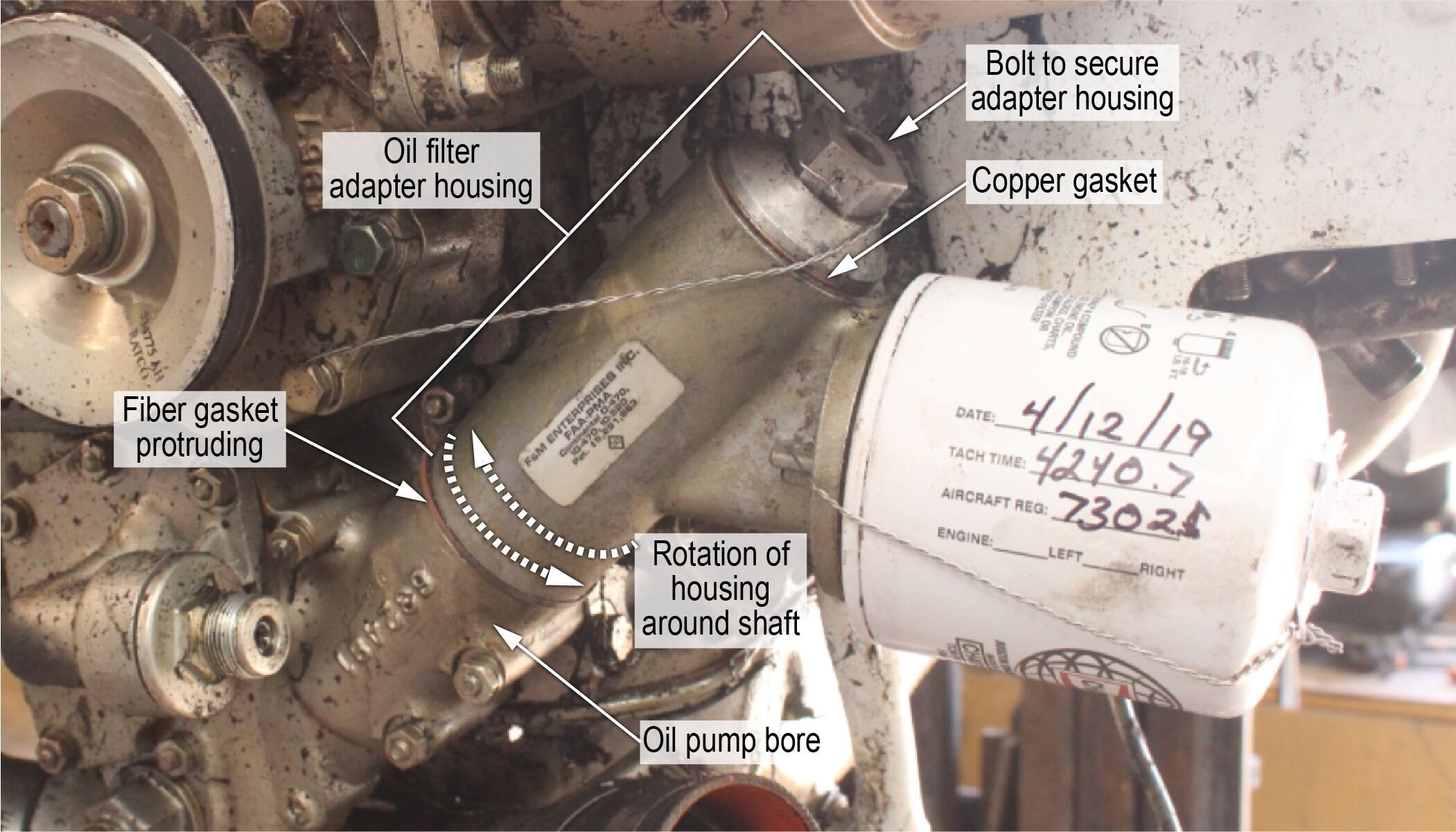 FAA Requires Sturdier Oil Gaskets After Several Planes Crash Due to Engine Oil Starvation
FAA Requires Sturdier Oil Gaskets After Several Planes Crash Due to Engine Oil Starvation
The NTSB’s investigation of several reciprocating-engine plane crashes found that their engines lost power during flight due to oil starvation caused by an oil filter gasket failure. In response to our recommendation (A-20-39) to address safety concerns with fiber gaskets, the FAA issued an airworthiness directive (AD) requiring owners to replace the fiber gaskets with sturdier copper gaskets before accumulating 50 flight hours or at the next scheduled oil change. The directive also prohibits any future use of the fiber gaskets. The FAA estimated that about 6,300 registered aircraft are subject to its directive. The fix costs about $246.50 per aircraft, including the $34 replacement gasket.
 FAA Requires Current Medical Certificates for Commercial Hot Air Ballon Pilots
FAA Requires Current Medical Certificates for Commercial Hot Air Ballon Pilots
The NTSB recommended (A-17-34) that the FAA require commercial balloon pilots to have a current FAA medical certificate following a July 2016 hot air balloon accident in Lockhart, Texas, which had the greatest number of commercial aviation fatalities since the 2009 Colgan Airlines accident near Buffalo. In Lockhart, the pilot made several errors, such as taking off in poor ground visibility and continuing into foggy areas where the balloon struck a high-voltage power line. The pilot used various drugs and had a medical history of conditions that should have disqualified him, including conditions likely to affect decision-making. At the time of the accident, balloon pilots were not subject to FAA medical fitness requirements. Following our recommendation, the FAA adopted a final rule requiring commercial hot-air balloon pilots to hold medical certificates when flying paying passengers, except when the pilot is conducting flight training in a balloon. The rule mandates a second-class medical certificate, the same standard required for other commercial pilots.

Safety Standard Update Aims to Prevent Natural-Gas-Fueled Explosions
In 2018, explosions from undetected natural gas leaks occurred at three Dallas homes on the same block, one day after the next. While the gas distribution company tested for underground gas leaks at the homes, the instruments failed to detect issues because of wet soil conditions. When the ground is saturated, gas may not vent as expected, leading to false-negative results during routine tests to detect the presence of gas.
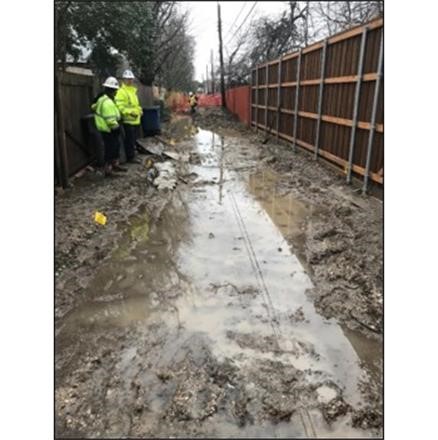 Following the NTSB's investigation of the natural-gas-fueled explosions, we issued several safety recommendations, including one to the Gas Piping Technology Committee (GPTC), which writes consensus guidelines to improve the safety of gas transmission, distribution, and gathering piping systems.
Following the NTSB's investigation of the natural-gas-fueled explosions, we issued several safety recommendations, including one to the Gas Piping Technology Committee (GPTC), which writes consensus guidelines to improve the safety of gas transmission, distribution, and gathering piping systems.
Recently, the NTSB closed our recommendation to the GPTC as an acceptable action following the committee's publication of additional guidance that provides steps gas distribution operators can take to thoroughly investigate and respond safely to leaks in wet weather conditions. Specifically, the GPTC added that operators should consider special one-time surveys where gas migration and the ability to quickly identify a suspected leak's location is affected by weather-related conditions, such as water-saturated ground.
The additional guidance also stresses the importance of assessing all potential migration paths, investigation tools, methods, and considerations when the ground is water saturated. If buildings are in the suspected area of migration, the guidance advises operators to follow emergency response procedures, including ventilation or evacuation and isolating the gas supply to the area until conditions improve.
The GPTC adheres to the American National Standard Institute's rigorous standard development processes and directly improves safety among gas distribution operators nationwide.
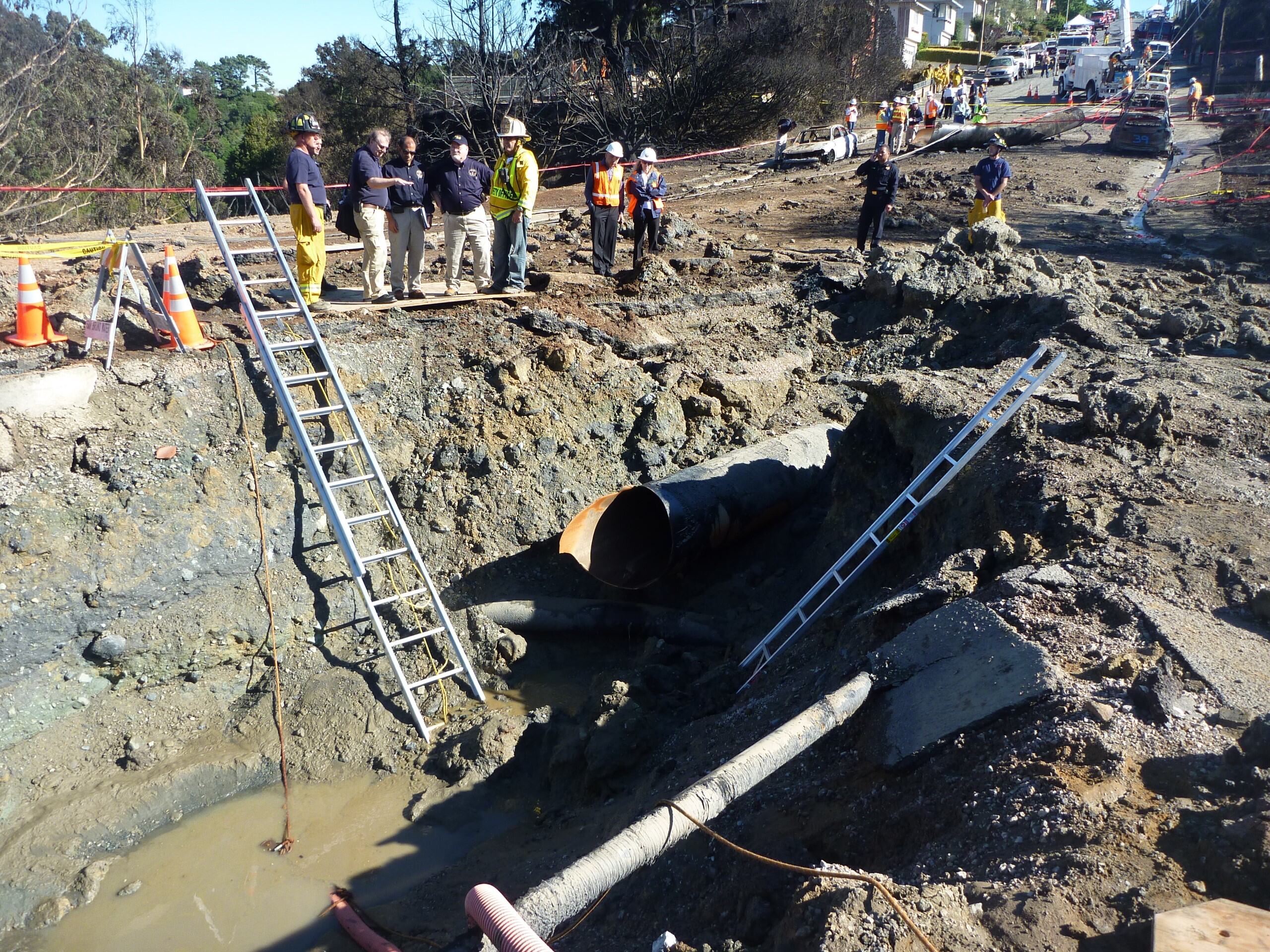 PG&E Completes Integrity Tests on Nearly 2,000 Miles of Natural Gas Pipeline to Prevent Another San Bruno Natural Gas Explosion
PG&E Completes Integrity Tests on Nearly 2,000 Miles of Natural Gas Pipeline to Prevent Another San Bruno Natural Gas Explosion
A Pacific Gas and Electric Company (PG&E) natural gas pipeline ruptured, triggering an eruption that leveled a San Bruno neighborhood on Sept. 9, 2010. The explosion and fire killed 8 people, injured 58, and destroyed 38 homes. Following our investigation, we recommended (
P-10-4) that PG&E determine its pipelines' maximum allowable operating pressure. The NTSB recently classified the recommendation as Closed-Acceptable Action because PG&E addressed it by completing strength-testing or verifying strength-test records for over 1,850 miles of pipeline.
Energy Company Fixes Policy and Procedural Weaknesses that Led to Three Dallas Home Explosions
In February 2018, three Dallas, Texas, homes on the same block exploded one day after another, killing one person and injuring several others. The NTSB’s investigation found that the energy company’s leak detection methods and response policies and procedures for natural gas explosions and fires were insufficient. We recommended (P-21-11) that the energy company, Atmos Energy, address those weaknesses. The company made the following changes:
- Leak investigation methods that are reliable in wet weather
- Leak investigation procedures that assess all viable gas migration paths
- Criteria for when to shut down or isolate gas distribution systems and pressure test main and service lines
- An alternate safe response, such as evacuation when reliable leak investigations are impossible due to wet weather or other circumstances

Getting Ahead of the Weather and Potential Catastrophic Derailments
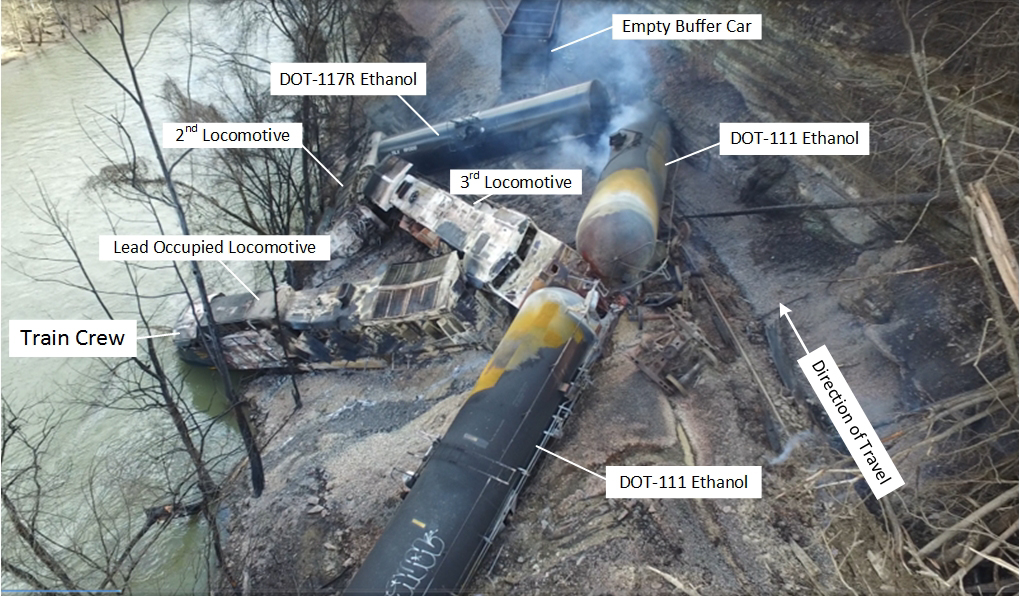 Weather-related railroad accidents account for a small percentage of all reported rail incidents, yet their consequences can be severe. Over the past 40 years, the NTSB has investigated several derailments where unforeseen adverse weather conditions impacted railroad infrastructure and created unsafe operating environments.
Weather-related railroad accidents account for a small percentage of all reported rail incidents, yet their consequences can be severe. Over the past 40 years, the NTSB has investigated several derailments where unforeseen adverse weather conditions impacted railroad infrastructure and created unsafe operating environments.
One notable incident occurred in 2020 when a high-hazard train transporting denatured ethanol derailed in Kentucky, between a hillside and a river. This derailment resulted in the release of 38,400 gallons of denatured ethanol, which ignited when it mixed with the locomotive's diesel fuel. Fortunately, the train crew evacuated with only minor injuries, despite the destruction of the locomotives.
The
NTSB's investigation into this derailment revealed that two weeks before the incident, the area experienced more than three times its average rainfall, leading to a mudslide that covered the tracks just before the derailment.
In response to this catastrophe, we recommended (R-22-8) that Class I Railroads and Amtrak improve their weather alert criteria by incorporating location-specific current, persistent, and past weather conditions that could lead to hazardous operating conditions. Additionally, we recommended (R-22-9) that the railroads train their employees on updates to their alert criteria and protocols in response to different alerts.
In November, our board members evaluated the response of Class I Railroads and Amtrak to our recommendations (R-22-8 and
R-22-9) and found that their weather alert criteria now include dynamic weather conditions that change over short and long periods, with an emphasis on location-specific current, persistent, and historical rainfall.
Rail Association Calls on Members to Hold Employee Safety Briefings on Lessons Identified from Tragic Collision
The NTSB issues safety recommendations to those entities that can take action to prevent the recurrence of similar transportation accidents and incidents. A fast and effective method of reaching our affected audiences with a safety message is through their trade associations and professional societies.
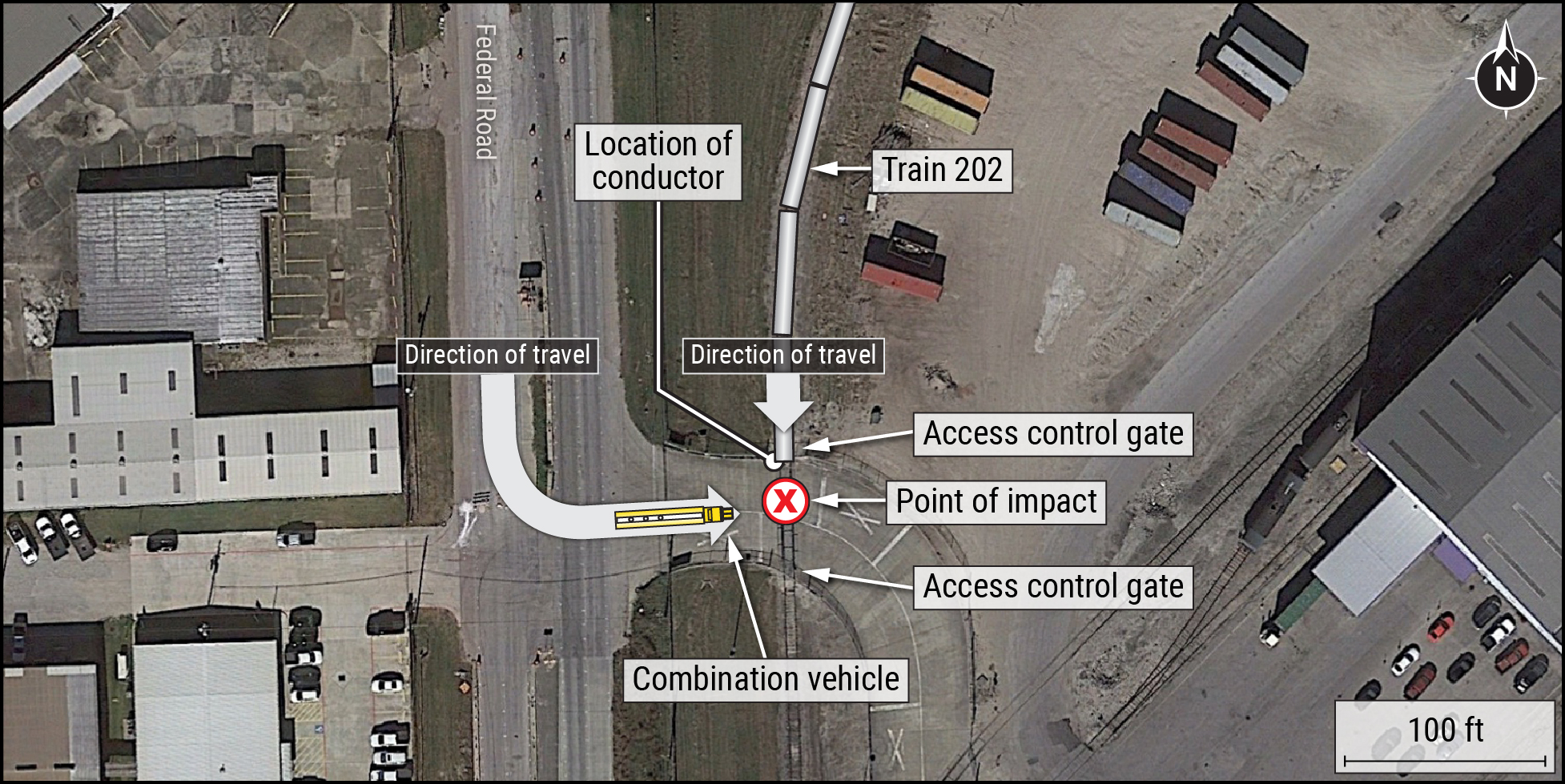 In 2021, the NTSB issued a recommendation to the American Short Line and Regional Railroad Association (ASLRRA) asking it to share with its members the circumstances of a 2021 collision that killed a 19-year-old train conductor, who was riding on the rear platform of a train slowly backing down the tracks (also known as shoving).
In 2021, the NTSB issued a recommendation to the American Short Line and Regional Railroad Association (ASLRRA) asking it to share with its members the circumstances of a 2021 collision that killed a 19-year-old train conductor, who was riding on the rear platform of a train slowly backing down the tracks (also known as shoving).
When the conductor’s rail car entered a highway-railroad grade crossing, an 18-wheeler struck it, pinning the conductor between the train and the truck. The grade crossing had warning signs but no mechanical gates to prevent crossing. Our investigation found that the truck driver did not heed the warning signs and failed to stop when entering the grade crossing.
In response to our recommendation (R-23-021), ASLRRA asked its members in its newsletter to read the details of the
NTSB investigation report, review their procedures related to shoving movements, and communicate them to their employees in an upcoming safety briefing. In the news article, the association also highlighted to its members: “The NTSB recommends that railroads require ground protection at highway-railroad grade crossings equipped only with flashing lights or passive warning devices.”
The NTSB recently closed the ASLRRA recommendation and classified the association's publication of an article in its member newsletter as acceptable.
CSX Railroad Trains Emergency Responders on Hidden Hazards to Reduce Risk
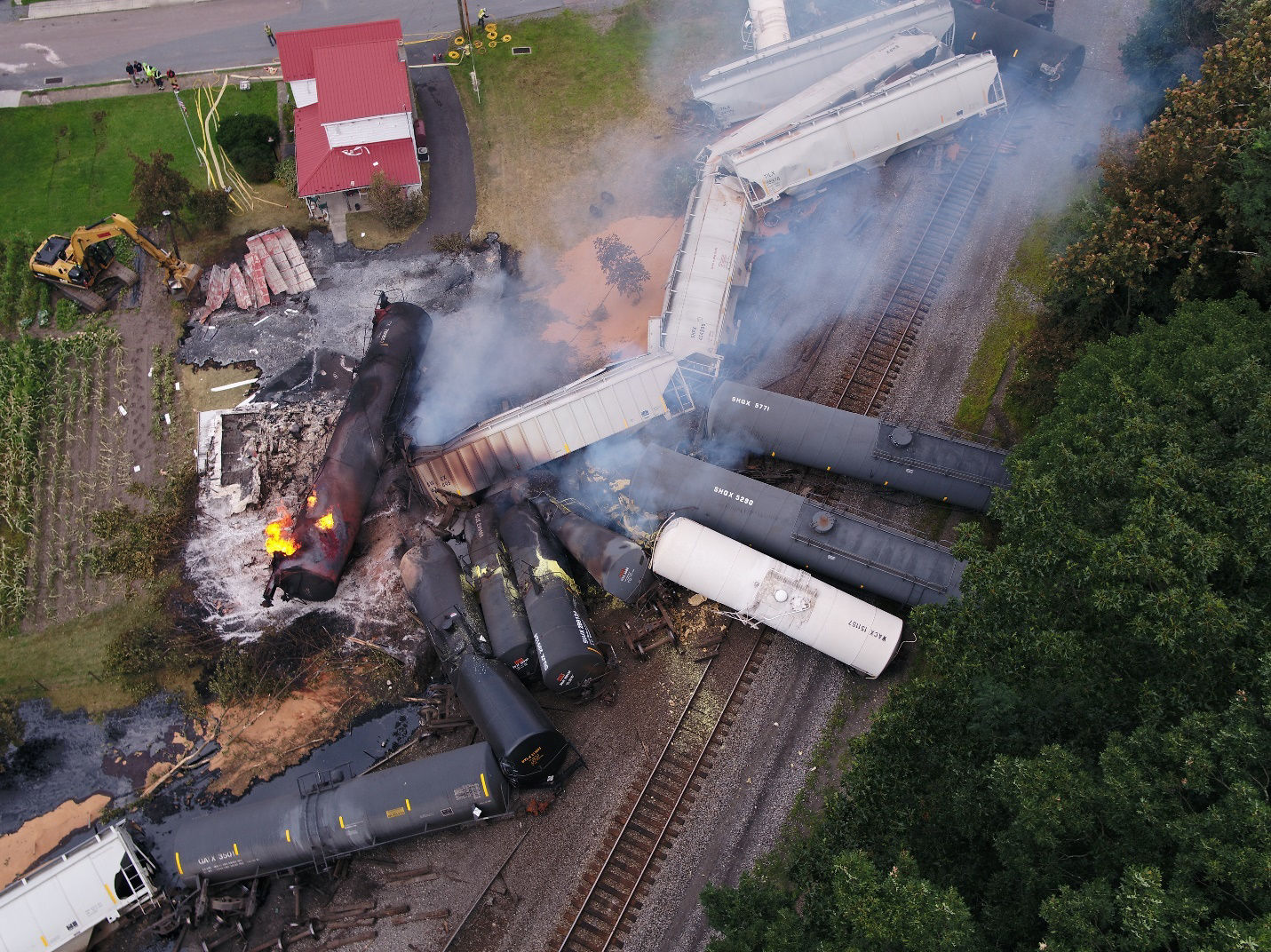 In a 2017 train derailment in Hyndman, Pa., involving several rail cars containing hazardous materials, CSX railroad's emergency responders put their lives at risk by working perilously close to the derailment scene to hasten stabilization.
In a 2017 train derailment in Hyndman, Pa., involving several rail cars containing hazardous materials, CSX railroad's emergency responders put their lives at risk by working perilously close to the derailment scene to hasten stabilization.
NTSB's
accident investigation discovered that emergency responders were unaware of a potentially hazardous bulge developing in the tank because the rail car's protective layer, known as a jacket, obscured the surface of the tank car's shell. The jacket is an eighth of an inch thick steel skin that wraps around the tank shell.
In response to NTSB's safety recommendation
(R-20-24), CSX revised its emergency responder training and outreach programs to incorporate lessons learned about jacketed tank cars from NTSB's investigation of the CSX train derailment. By 2025, rail tank cars carrying crude oil and ethanol will be required to be jacketed.
CSX also built a full-size model train called a Responder Incident Training (RIT) train to give emergency first responders hands-on experience with the safety features of jacketed tank cars.
After NTSB staff attended CSX's in-person and virtual training, the NTSB classified CSX's response to our safety recommendation as acceptable. While the in-person training is only available on CSX properties, the virtual
Emergency Response to Rail Incidents (ERRI) training is free to the public on the Transportation Community Awareness Emergency Response's website.
Emergency response is an aspect the NTSB commonly assesses during its accident investigations. Recently, NTSB's investigation of the Feb. 3, 2023, Norfolk Southern train derailment and hazardous materials release in
East Palestine, Ohio, again highlighted the importance of effective emergency response.
 NYC Mass Transit Creates a System of Continuous Safety Improvement
NYC Mass Transit Creates a System of Continuous Safety Improvement
Following the NTSB’s investigation of a series of accidents on New York City’s commuter and inner-city mass transit system, we issued several recommendations (R-14-66 thru -68) to the Metropolitan Transportation Authority (MTA) to identify and mitigate hazards across the city’s entire transit system. In response, the MTA created a safety council comprised of safety officers from each of the MTA’s railroads that meet each week to review safety data, trends, hazards, and mitigations. The council shares that information monthly with the MTA railroad presidents and board members. The forum enables the MTA to systematically evaluate deficiencies identified on one MTA property and apply the hazard mitigations to the others. We recently classified our recommendations to the MTA as Closed-Acceptable Action.
 WMATA Improves Operator Emergency Shutdown Training, Implements Recurring Ventilation System Testing
WMATA Improves Operator Emergency Shutdown Training, Implements Recurring Ventilation System Testing
Our 2015 investigation of a WMATA Yellow line train that encountered heavy smoke while leaving the L’Enfant Plaza station heading toward the Potomac River Bridge identified issues with the train operator not correctly shutting the railcar ventilation system down to minimize smoke being pulled into an occupied WMATA car. We recommended WMATA train operators on emergency shutdown procedures and regularly test railcar ventilation systems. WMATA revised its operator training to ensure that operators can take needed emergency actions and implemented recurring testing of its railcar ventilation systems. (Safety Recommendations R-16-19 and
R-16-20.)

From Tradegy to Reform: Safety Gains Since the Conception Dive Boat Fire
On
September 2, 2019, a devastating fire swept through the Conception dive boat off the California coast, killing 33 passengers and one crew member in one of the deadliest maritime disasters in recent U.S. history. Trapped in a below-deck bunkroom, they had no warning and no way out.
Six years later, we honor the lives lost and recognize the progress made. Many overdue safety reforms have been implemented, fulfilling several key NTSB recommendations. These improvements represent a significant step forward in safeguarding passengers and crew aboard small passenger vessels.
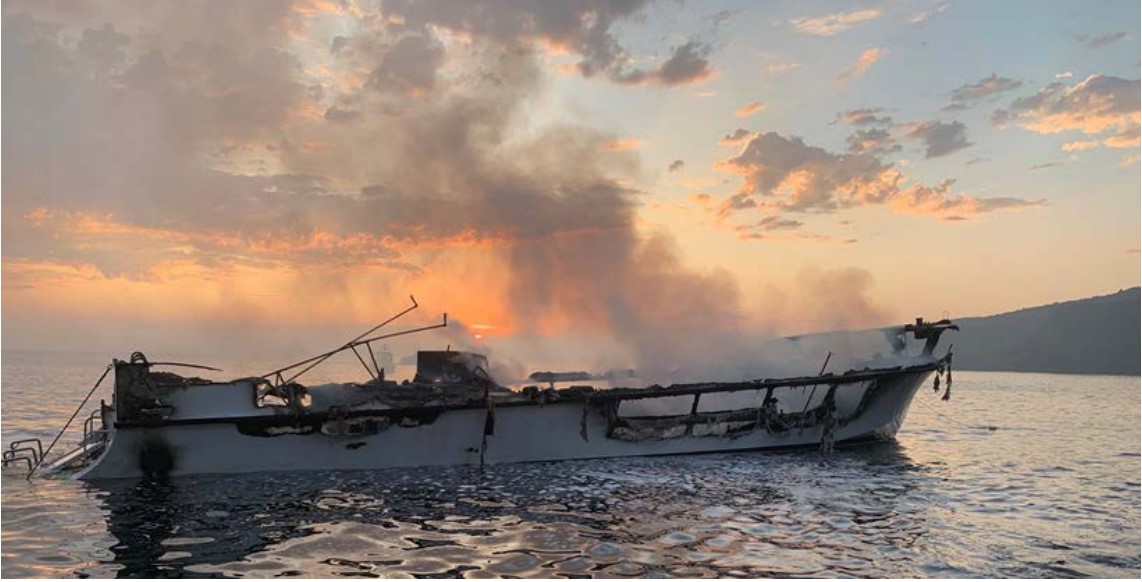 What Went Wrong
What Went Wrong
NTSB’s investigation of the Conception fire revealed critical safety failures:
- No interconnected smoke alarms—crew never heard a warning.
- No roving patrol (crewmember watch) and means to verify that roving patrols are being conducted—no one awake to ensure safety or detect and respond to the fire.
- Inadequate escape routes—both exits from the bunkroom led to the same compartment, which was blocked by a large fire.
- Unsafe battery charging practices—lithium-ion batteries used to charge phones and other devices likely ignited the blaze.
- Inconsistent enforcement of safety rules—key safety requirements were not being followed.
In October 2020, the NTSB concluded the probable cause was a lack of effective oversight by the operator and insufficient Coast Guard regulations to ensure safe overnight operations.
What’s Been Done to Make Vessels Safer
Congressional Action
Following the tragedy, Congress passed the Small Passenger Vessel Safety Act, which was later included in the Coast Guard Authorization Act of 2020 and the 2021 National Defense Authorization Act. The law directed the Coast Guard to upgrade fire safety requirements and implement NTSB recommendations aimed at enhancing the protection of passengers and crew.
Coast Guard Regulations
As mandated by the law, the Coast Guard issued new rules effective March 2022 to improve fire safety on overnight passenger vessels carrying more than six people. Requirements include:
- Smoke detection systems in all accommodation spaces (M-20-14,
M-20-15,
-20-M--20-16)
- A monitored, mandatory night roving patrol (M-20-17) to stay alert while passengers sleep
- A secondary escape route that leads to a different space than the primary exit, reducing the risk that a single fire blocks both ways out. (M-20-18,
M-20-19,
M-20-20)
- Crew fire training and drills
- Logbooks to record fire system checks, night roving patrols, and emergency drills
To enforce these rules, the Coast Guard also launched nationwide inspections to ensure that these requirements are being met.
Still Needed: Safety Management Systems (SMS)
While we are encouraged that many NTSB recommendations have been implemented, one critical recommendation remains unfinished: requiring operators of U.S.-flag passenger vessels to implement safety management systems. Until that gap is closed, passengers and crews remain at unnecessary risk.
The NTSB has urged action on SMS for more than 20 years. We reiterated this recommendation after the Island Lady fire in 2018, before the Conception tragedy. Had SMS been in place, Truth Aquatics, the operator of Conception, could have identified unsafe practices, corrected fire risks, and prevented loss of life.
Although the Coast Guard issued an advance notice of proposed rulemaking in 2021, final SMS regulations are still pending. Until they are in place, this remains the NTSB’s oldest open marine safety recommendation. Visit our SMS for Passenger Vessels page to learn more.
Why This Matters
Thanks to changes driven by NTSB recommendations, passenger vessels like Conception are now safer: alarms are interconnected, escape routes are safer, roving patrols are required to be verified, and battery charging risks are better managed. These lifesaving reforms address the very hazards that contributed to the Conception tragedy, representing real progress.
On this solemn sixth anniversary, we remember the 34 lives lost. And we continue to urge the Coast Guard to require SMS on all passenger vessels. Only then will operators be able to move from reacting to hazards toward preventing them altogether.
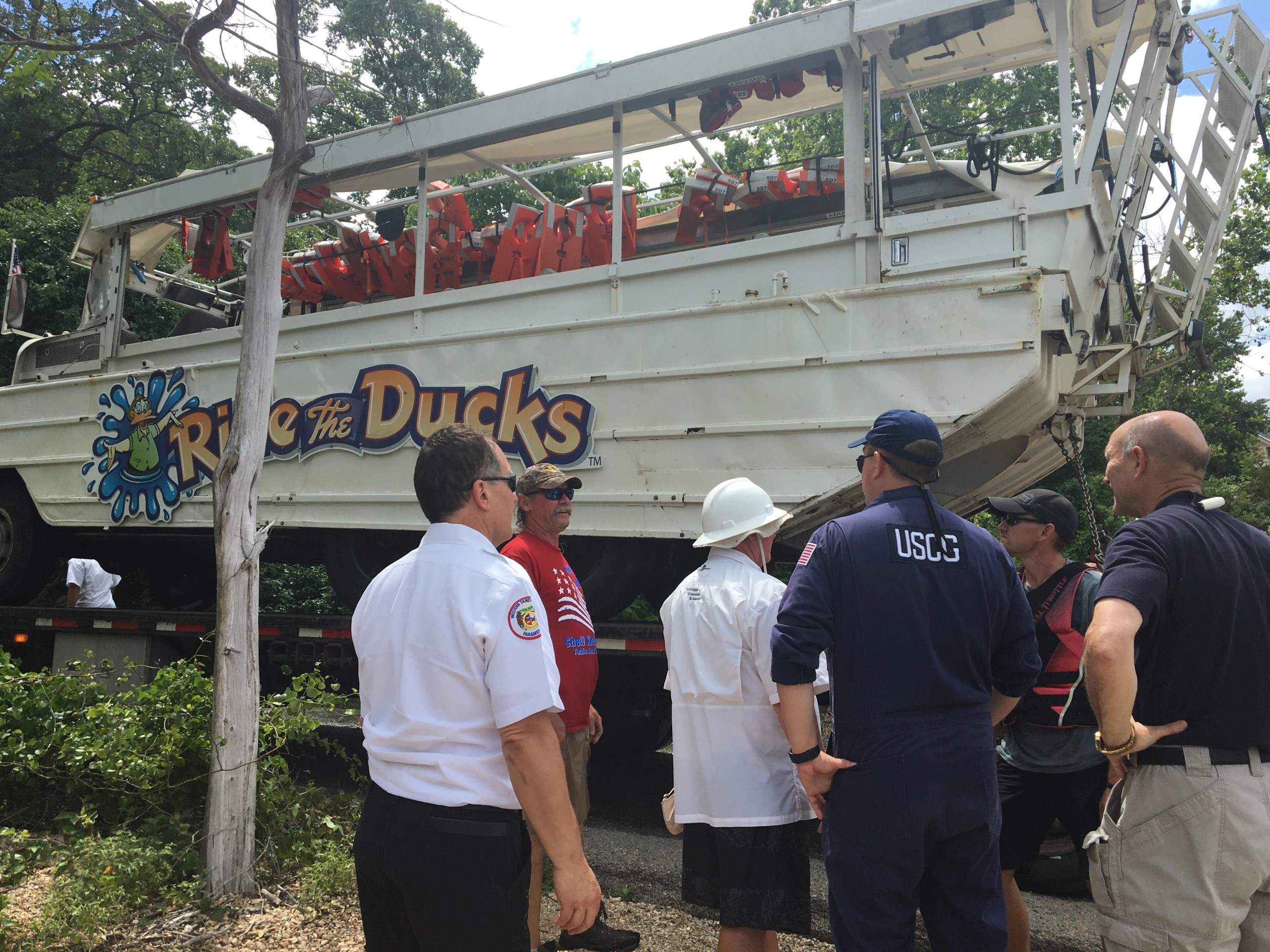
U.S. Coast Guard Improves Duck Boat Safety for Sightseers
Five years after 17 lives were lost when a DUKW amphibious (duck) boat capsized and sank during a storm on Missouri’s Table Rock Lake, the Coast Guard published a
rule on Sept. 13, 2023, requiring duck boat operators to implement several safety measures we recommended. Duck boat operators had 120 days from the date the interim rule was published (Sept. 11, 2023) to comply with the requirements.
The nine requirements listed in the Coast Guard’s interim rule are aimed at preventing the boats from filling with water and improving passenger survival if they capsize and sink.
The nine requirements are:
- Remove the canopies and any window coverings of such vessels for waterborne operations or install a canopy that does not restrict horizontal or vertical escape by passengers in the event of flooding or sinking;
- If a canopy and window coverings are removed from any such vessel pursuant to paragraph (1), require that all passengers wear a personal flotation device approved by the Coast Guard before the onset of waterborne operations of such vessel;
- Re-engineer such vessels to permanently close all unnecessary access plugs and reduce all through-hull penetrations to the minimum number and size necessary for operation;
- Install independently powered electric bilge pumps that can dewater such vessels at the volume of the largest remaining penetration in order to supplement an operable Higgins pump or a dewatering pump of equivalent or greater capacity;
- Install not fewer than four independently powered bilge alarms;
- Conduct an in-water inspection of any such vessel after each time a through-hull penetration has been removed or uncovered;
- Verify the watertight integrity of any such vessel through an in-water inspection at the outset of each waterborne departure;
- Install underwater light emitting diode (LED) lights that activate automatically in an emergency; and
- Otherwise, comply with any other provisions of relevant Coast Guard guidance or instructions in the inspection, configuration, and operation of such vessels.
The Coast Guard’s rulemaking satisfied our Safety Recommendation M-19-16, recommending that the Coast Guard require DUKW boat operators to remove canopies, side curtains, and their associated framing during waterborne operations to improve emergency egress in the event of sinking.
 Coast Guard Improves Vessel Traffic System’s Role in Safely Managing Marine Traffic
Coast Guard Improves Vessel Traffic System’s Role in Safely Managing Marine Traffic
In 2016, the NTSB completed a study of the Coast Guard’s Vessel Traffic System (VTS), a marine traffic monitoring system established by harbor or port authorities, similar to air traffic control for aircraft. We issued 17 recommendations to the Coast Guard to address safety issues found in the investigation. The Coast Guard recently reported to us that it has taken several actions in response, including revising its VTS National Standards for Operating Instruction. As a result, we classified 9 of our 17 recommendations Closed-Acceptable Action. (M-16-6)

Enhancing Child Passenger Safety
For decades, the safety of young passengers has been a critical focus for the NTSB. In particular, the proper use of child safety restraint systems, seatbelts, and airbags has been a key factor in reducing child fatalities and injuries in vehicle accidents.
Montana was among the states that had not fully updated its laws to align with national standards for child passenger safety. However, after 30 years of advocacy and sustained efforts by the NTSB, child safety advocates, and state lawmakers, Montana has now passed legislation (HB 586) that revises its child restraint system laws, marking a significant milestone in the state’s commitment to protecting its youngest passengers.
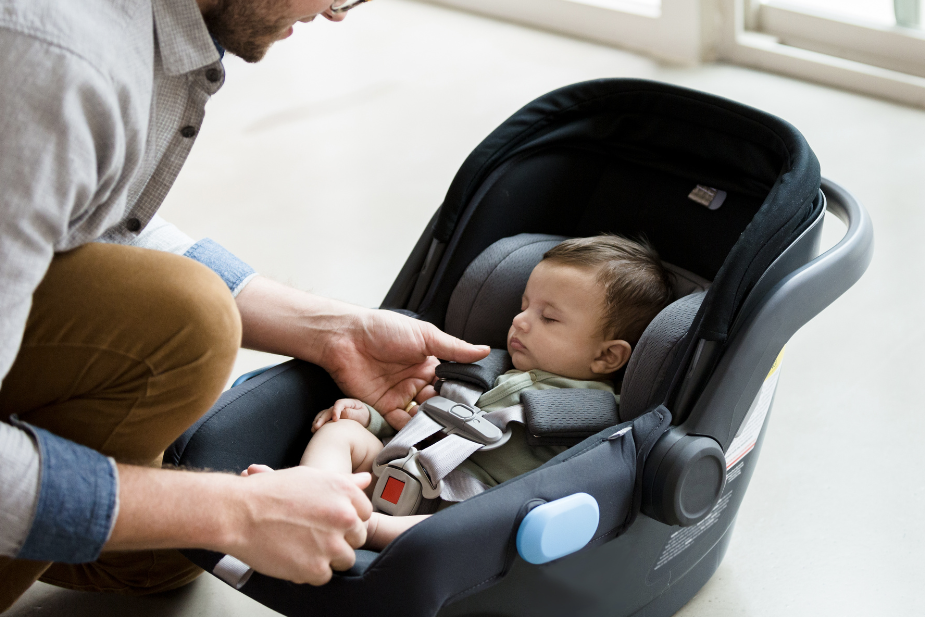 Key Safety Improvements
Key Safety Improvements
Following the NTSB's recommendation (H-96-14), which mandates that children up to 8 years old must use child restraint systems and booster seats under the state's child restraint use law, Montana has taken critical steps to enhance its child passenger safety laws. The newly enacted HB 586 revises the state's regulations to require that:
- Children under 2 years old must be in a rear-facing child safety seat.
- Children aged 2-4 must be in a rear-facing seat or a forward-facing seat with an internal harness.
- Children aged 4-8 must use a forward-facing seat or booster seat, depending on their size.
- Children aged 9 and older must be secured with an adult seatbelt once they outgrow booster seat requirements.
These updates ensure that Montana’s laws now fully reflect best practices in child safety, reducing the likelihood of severe injuries and fatalities in crashes.
Why This Matters
According to National Highway Traffic Safety Administration’s (NHTSA) 1994 Fatal Accident Reporting System (FARS) data, over 5,900 children were involved in fatal vehicle accidents each year, many of whom were unrestrained or improperly restrained. However, in 2022, NHTSA reported 1,129 traffic fatalities among children aged 14 and younger in the United States. This decline highlights the progress made in child passenger safety, but it also emphasizes the continued need for proper child restraint use and safety measures to further reduce fatalities and injuries.
NTSB’s 1996 safety study highlighted that unrestrained children are twice as likely to be killed in an accident compared to those who are properly secured.
A Step Forward, but Work Remains
We celebrate Montana for closing this recommendation after three decades of advocacy. However, several states:
Alabama, Arkansas, Florida, Iowa, Nevada, and South Dakota, still have not fully implemented child restraint system laws that align with national standards and still have open NTSB recommendations. The NTSB urges these states to take similar actions to protect their young passengers and reduce the risk of preventable fatalities.
The progress made in Montana demonstrates the impact of safety recommendations and the continued need for proactive measures across the country.
NHTSA Takes Important Step Toward Standardizing Impaired-Driver Toxicology Testing Nationwide
 On New Year’s Day 2021, a 28-year-old drug-impaired driver swerved his sport utility vehicle (SUV) into oncoming traffic on a two-way road near Avenal, Calif., and collided head-on with a pick-up truck carrying an adult driver and seven children. The SUV driver and all eight pickup truck occupants died.
On New Year’s Day 2021, a 28-year-old drug-impaired driver swerved his sport utility vehicle (SUV) into oncoming traffic on a two-way road near Avenal, Calif., and collided head-on with a pick-up truck carrying an adult driver and seven children. The SUV driver and all eight pickup truck occupants died.
In this
highway investigation, the NTSB found that the driver’s blood alcohol concentration was more than double California's legal limit. Unfortunately, the NTSB could not determine if other drugs contributed to the driver's impairment because the Fresno County medical examiner's postmortem toxicology testing of the driver's blood did not screen for other common drugs. The NTSB later detected cannabis in the driver's blood when conducting its post-crash toxicology tests.
For alcohol impairment, years of experience and a robust data-gathering process have reliably established detectable levels of blood alcohol associated with impairment. However, for other widely available drugs, both legal and illicit, the data available are insufficient to develop enforceable impairment markers and effective countermeasures.
We could improve the information on the prevalence of impairing drug use by drivers if testing protocols were standardized. Like many other states, California had no uniform standard for drug toxicology testing at the time of the 2021 Avenal crash.
Following our investigation, the NTSB issued a safety recommendation
(H-22-33) to the National Highway Traffic Safety Administration (NHTSA) to disseminate a nationally recognized drug toxicology testing standard to state officials.
The NTSB recently closed its recommendation to NHTSA as an acceptable action when NHTSA distributed the National Safety Council's "Recommendations for Toxicological Investigations of Drug-Impaired Driving and Motor Vehicle Fatalities through the Regional Toxicology Liaison Program" to all state officials.
NTSB’s School Bus Stop-Arm Camera Recommendation Takes Hold in the States
NTSB’s call for states to permit school bus stop-arm cameras is steadily taking hold across the country, with 25 states enacting laws to prevent illegal school bus passings that have reached an epidemic level, putting student safety at risk.
Florida, Michigan, and Delaware are the most recent states to adopt NTSB’s stop-arm camera safety recommendation, which the agency issued in 2020 to 28 states and the District of Columbia. The agency made the recommendation (H-20-12) following its investigation of a 2018 Rochester, Indiana crash, where three children were struck and killed and another severely injured when crossing a two-lane highway to board their school bus.
The National Association of State Directors of Pupil Transportation Services estimates that over 41 million vehicles illegally passed school buses in a 180-day school year. Stop-arm cameras record the license plates of vehicles illegally passing school buses, enabling police to issue citations to violators, an effective deterrent to dangerous driver behavior.
Read NTSB’s testimony in support of stop-arm camera legislation before Oregon’s House Judiciary Committee.
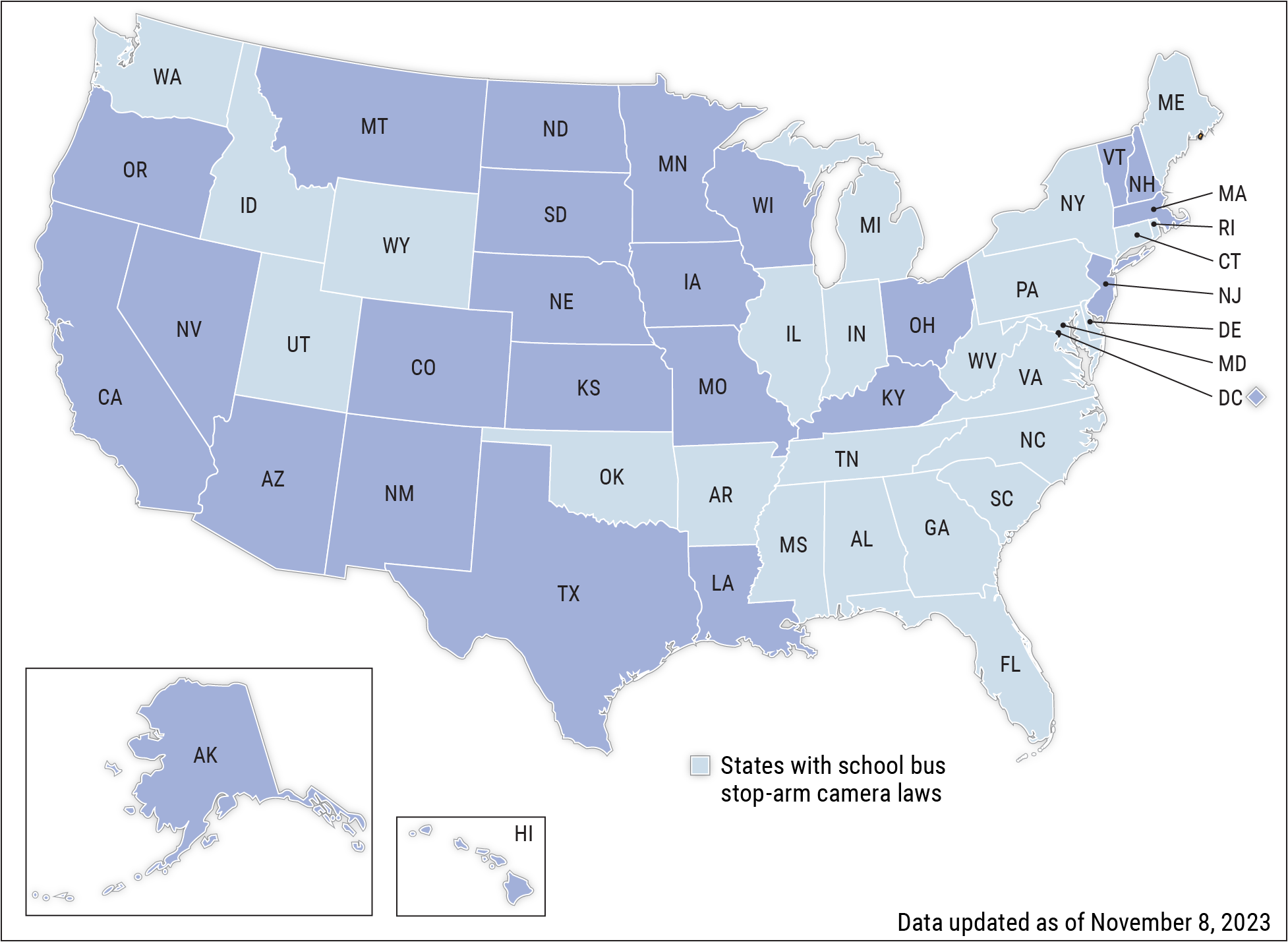
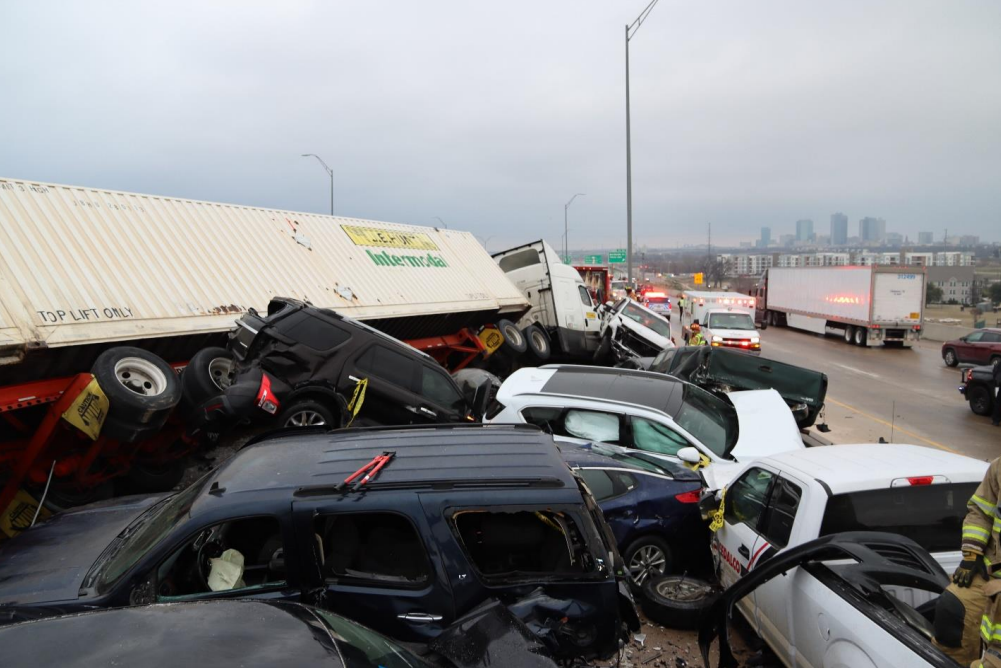 Texas Adopts NTSB’s Recommendation to Use Variable Speed Limits to Prevent Highway Crashes
Texas Adopts NTSB’s Recommendation to Use Variable Speed Limits to Prevent Highway Crashes
Following the NTSB’s recommendation that Texas use variable speed limit signs to reduce crashes occurring on its highways during inclement weather, the state recently authorized the Texas Transportation Commission to use them on its roads.
Variable speed limit signs, unlike static ones, can be adjusted when changing road conditions require safer speed limits to reduce the risk of highway crashes.
The NTSB first asked Texas (H-05-20) to install variable speed limit signs following the agency’s investigation of a 2003 crash near Hewitt, Texas, where a motorcoach bus skidded during braking, crossed over a grassy median, entered the southbound lane, and collided with an SUV. The crash occurred during inclement weather with reduced visibility due to fog, haze, and heavy rain. Seven people died, and several other people were injured in the crash.
In 2023, the NTSB asked Texas again (H-23-3) to use variable speed limit signs following the agency’s investigation of a 2021 Fort Worth crash where six people died in a multivehicle pileup on an icy highway with a posted speed of 75 miles per hour.
Updated August 5, 2025